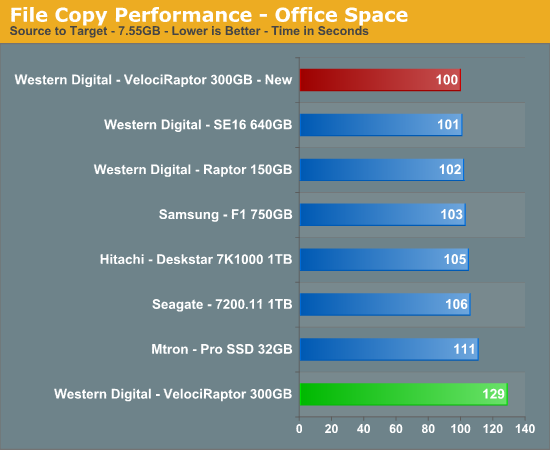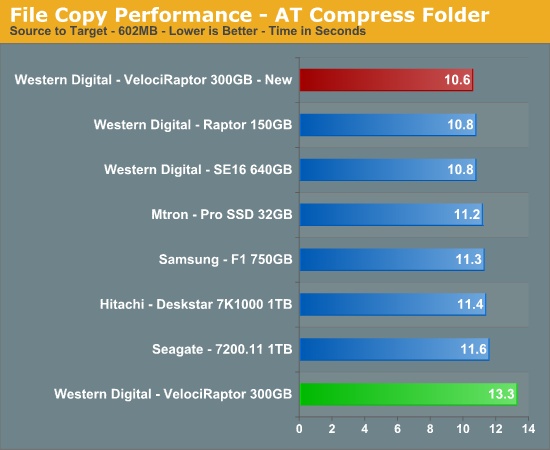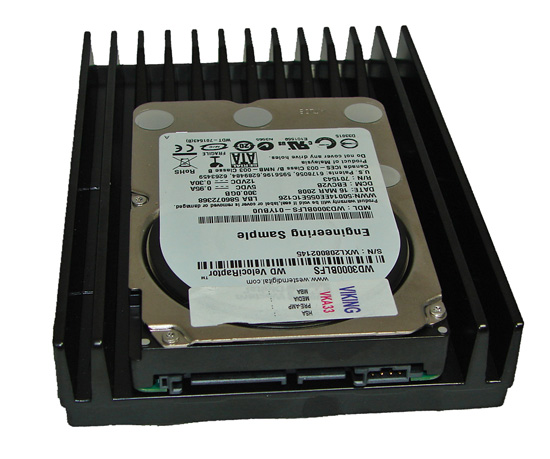Western Digital VelociRaptor: A Drive with a Bite
by Gary Key on April 22, 2008 4:00 AM EST- Posted in
- Storage
File Copy Performance
Our file copy test measures the time it takes to transfer our first test folder that contains 29 files, 1 folder, and has 7.55GB of data from our source drive to the target test drive. The second test folder contains 444 files, 10 folders, and 602MB of data. These benchmarks are disk write intensive and require a fast storage system.


We finish our application tests with benchmarks that should favor the Raptor family because it represents a pure write scenario where speed kills. In this case, our VelociRaptor got its talons handed to it. We ran these tests repeatedly with the same results for the most part. The sustained write performance of the VelociRaptor was continually hampered by the slowdown/speedup write operations on the outer tracks.

First Thoughts
We are actually not going to come to any conclusions yet on what appears to be a very impressive piece of engineering work from Western Digital. The VelociRaptor VR150 is indeed a huge leap in design - and in certain cases, performance - over the original Raptor. While the two drives share a common 10k RPM design, everything else about the drives, sans the warranty and black paint, is different.
Sometimes changing too much leads to disaster, but in this case, we are glad that Western Digital burned the Raptor blueprints and started over. The 2.5" form factor, low power consumption, and excellent acoustics will be appreciated in the enterprise market where saving money on energy and storage footprints are extremely important now, or should be. In a nod to the enthusiast sector that made the original Raptors kings of desktop performance, Western Digital did not leave us out in the cold, but instead provided the IcePAK chassis for our 3.5" form factor case requirements.
Our only problem at this point is that we could not complete our review. The early firmware problems caused havoc in our application benchmarks, so much so that we left out several results, as we knew the drive should perform better. Our comparisons against entry-level SAS drives suffered the same fate. Yes, the drive was extremely fast in IOMeter and other tests we ran, but we did not trust the results at this point. We expect new firmware and a new drive shortly and will finish our review at that time. Until then, this is one dinosaur we would not want to mess with.










31 Comments
View All Comments
DeepThought86 - Thursday, April 24, 2008 - link
Why oh why do you people insist on using new benchmarks all the time? How stupid is it that I can't go to your review of the Seagate 500GB from just last year and be able to compare performance with this new Velociraptor.Zak - Sunday, April 27, 2008 - link
Hm, so I guess this is not going to fit in a Mac Pro due to non-standard connector position. I bet there will be 3rd party replacements, but will this void the warranty?Z,
mvrx - Thursday, April 24, 2008 - link
I still find it strange that a drive only has 32MB of cache.. I'd think a gig or two would be on some high end drives..Xean - Wednesday, April 23, 2008 - link
Is it suitable for laptops?strikeback03 - Wednesday, April 23, 2008 - link
As they mentioned, only ones that accept unusually tall 2.5 inch drives.Fricardo - Tuesday, April 22, 2008 - link
What happened to the hard drive review article that was supposed to come out a month or so ago? I'd really like to see a full comparison, especially of the new WD and Samsung drives.Deusfaux - Tuesday, April 22, 2008 - link
#1. Tech Report says:"Western Digital says it's also working on a single-platter version of the drive, but that's not ready yet."
Gary can you verify this one way or another? What would the timeframe be?
#2. I have a couple spike drops when I bench one of my 2 Raptors with HDTach/HDTune. They're not right at the start, but they're there all the same.
What do they mean? I don't have them on my other Raptor.
Araemo - Tuesday, April 22, 2008 - link
Haven't all raptors(and indeed, most 10k and 15k rpm drives) used 2.5" platters in their large casings? I thought that most/all high-end drive manufacturers used 2.5" platters due to the high angular velocities and vibration.In that case - the smaller drive size shouldn't have any negative impact on performance at all.
GhandiInstinct - Tuesday, April 22, 2008 - link
In 2008, for their next generation Raptor, only 16MB Cache?CK804 - Monday, April 28, 2008 - link
Do people read anymore? The explanation is given on the second page:While the hot option on the latest 750GB~1TB drives is a 32MB buffer, WD is once again staying the course with a highly optimized 16MB cache. WD states they did not see any advantages to a 32MB cache on this drive and instead spent their engineering resources on optimizing the cache algorithms.